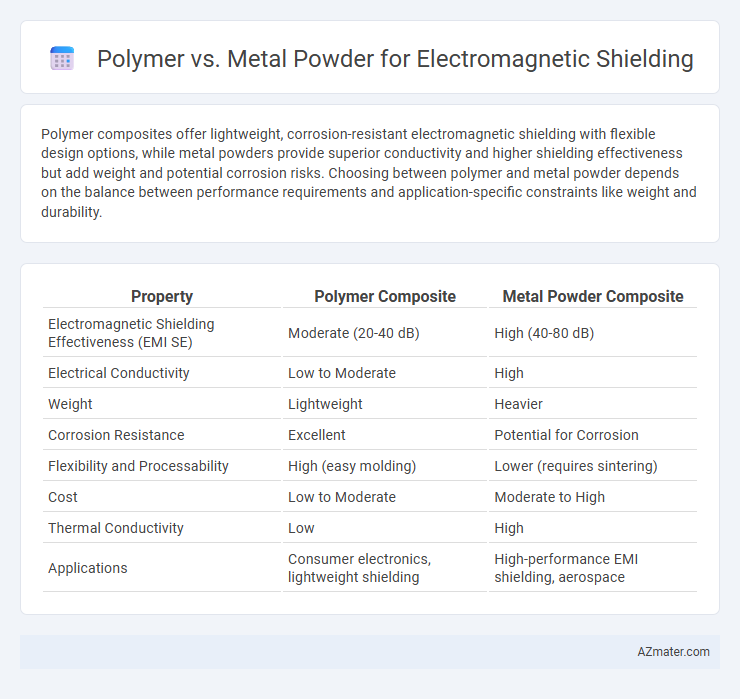Polymer composites offer lightweight, corrosion-resistant electromagnetic shielding with flexible design options, while metal powders provide superior conductivity and higher shielding effectiveness but add weight and potential corrosion risks. Choosing between polymer and metal powder depends on the balance between performance requirements and application-specific constraints like weight and durability.
Table of Comparison
| Property | Polymer Composite | Metal Powder Composite |
|---|---|---|
| Electromagnetic Shielding Effectiveness (EMI SE) | Moderate (20-40 dB) | High (40-80 dB) |
| Electrical Conductivity | Low to Moderate | High |
| Weight | Lightweight | Heavier |
| Corrosion Resistance | Excellent | Potential for Corrosion |
| Flexibility and Processability | High (easy molding) | Lower (requires sintering) |
| Cost | Low to Moderate | Moderate to High |
| Thermal Conductivity | Low | High |
| Applications | Consumer electronics, lightweight shielding | High-performance EMI shielding, aerospace |
Introduction to Electromagnetic Shielding Materials
Electromagnetic shielding materials are critical for protecting electronic devices from electromagnetic interference (EMI) by blocking or absorbing electromagnetic waves. Metal powders, such as copper, aluminum, and nickel, are commonly used due to their excellent conductivity and high shielding effectiveness across a broad frequency range. Polymer-based composites combined with conductive fillers offer lightweight, corrosion-resistant alternatives, enabling flexible design options while maintaining sufficient EMI attenuation for various industrial applications.
Overview of Polymer and Metal Powders
Polymer powders used for electromagnetic shielding typically consist of conductive fillers such as carbon black, carbon nanotubes, or metal-coated particles embedded in a polymer matrix, offering lightweight, corrosion-resistant, and flexible shielding solutions compatible with various fabrication methods. Metal powders, including aluminum, copper, nickel, and silver particles, provide superior electrical conductivity and higher shielding effectiveness due to their dense metallic composition but often add weight and may be prone to oxidation. The selection between polymer and metal powders depends on the application requirements for shielding efficiency, mechanical properties, environmental stability, and cost.
Electrical Conductivity: Polymer vs Metal Powders
Metal powders exhibit significantly higher electrical conductivity compared to polymer powders, making them more effective for electromagnetic shielding applications requiring efficient attenuation of electromagnetic waves. While polymer powders can be engineered with conductive fillers, their inherent conductivity remains substantially lower than metals like copper, silver, or nickel, limiting their shielding effectiveness. The superior conductivity of metal powders ensures better reflection and absorption of electromagnetic interference, enhancing overall shielding performance in sensitive electronic environments.
Magnetic Permeability Differences
Polymer powders exhibit significantly lower magnetic permeability compared to metal powders, limiting their effectiveness in electromagnetic shielding applications where magnetic field attenuation is critical. Metal powders, especially those composed of ferromagnetic materials like iron, nickel, or cobalt, demonstrate high magnetic permeability, enabling them to absorb and redirect magnetic flux efficiently. This difference in magnetic permeability directly impacts the shielding performance, making metal powders preferable for environments requiring robust magnetic interference mitigation.
Attenuation Efficiency Comparison
Metal powders typically exhibit higher attenuation efficiency for electromagnetic shielding due to their excellent electrical conductivity and intrinsic magnetic properties, enabling effective reflection and absorption of electromagnetic waves. Polymer composites infused with metal powders provide enhanced flexibility and corrosion resistance but generally deliver lower attenuation compared to pure metal powders alone. The efficiency of shielding depends on factors like particle size, filler concentration, and frequency range, with metal powders generally outperforming polymers in broadband attenuation performance.
Weight and Density Considerations
Polymer-based electromagnetic shielding materials typically offer significant weight reduction compared to metal powders due to their lower density, making them ideal for applications requiring lightweight components such as aerospace and portable electronics. Metal powders, with densities typically ranging from 7 to 11 g/cm3 depending on the metal, provide higher shielding effectiveness but at the cost of increased weight and potential structural rigidity. Selecting between polymer composites embedded with conductive fillers and traditional metal powder shields depends largely on the trade-off between the desired mass savings and the required electromagnetic attenuation performance.
Corrosion Resistance and Durability
Polymer composites with metal powders offer enhanced corrosion resistance compared to traditional metal powders used in electromagnetic shielding, as polymers act as protective matrices that prevent oxidation and degradation. Metal powders provide superior durability and mechanical strength but are more susceptible to corrosion, especially in harsh environmental conditions, which can compromise long-term shielding effectiveness. The combination of corrosion-resistant polymers and conductive metal fillers optimizes durability and electromagnetic interference (EMI) shielding performance in diverse applications.
Thermal Management Capabilities
Polymer powders used in electromagnetic shielding composites generally exhibit lower thermal conductivity compared to metal powders, limiting their effectiveness in heat dissipation applications. Metal powders, such as copper and aluminum, offer superior thermal management capabilities due to their high intrinsic thermal conductivity and ability to form continuous conductive networks. Incorporating metal powders enhances the composite's capacity to efficiently dissipate heat generated by electromagnetic interference, making them preferable for high-performance thermal management in shielding materials.
Cost-Effectiveness and Manufacturing Flexibility
Polymer composites embedded with metal powders provide a cost-effective alternative to pure metal powders for electromagnetic shielding due to lower material costs and reduced processing energy requirements. Manufacturing flexibility is enhanced with polymer-based shielding materials as they allow for easier molding into complex shapes and integration with other components using conventional plastic fabrication techniques. Metal powders, while offering superior conductivity and shielding effectiveness, typically require more expensive processing methods such as sintering or metal injection molding, limiting their adaptability for rapid prototyping or low-volume production.
Application Suitability: Choosing the Right Shielding Material
Polymer powders are lightweight, flexible, and corrosion-resistant, making them ideal for applications requiring conformal coatings or wearable electronics with electromagnetic shielding. Metal powders, such as copper or nickel, offer superior conductivity and higher shielding effectiveness, suited for industrial settings where durability and high-performance shielding against strong electromagnetic interference are critical. Selecting the right material depends on the device's environmental conditions, mechanical requirements, and the frequency range of electromagnetic exposure.

Infographic: Polymer vs Metal powder for Electromagnetic shielding
 azmater.com
azmater.com